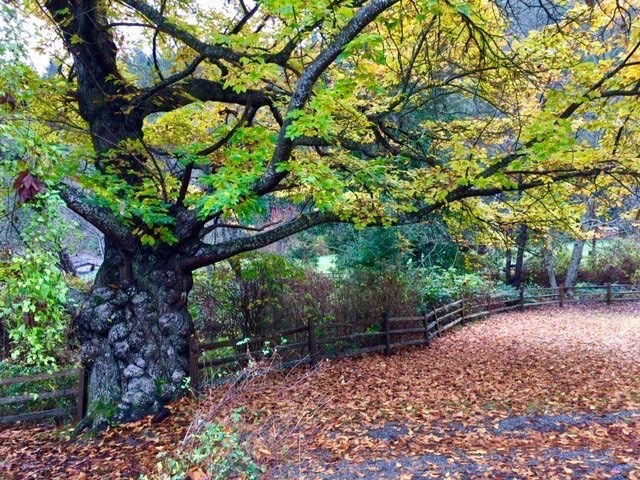But its blooms have no more blooms to answer them. No mates exist for countless miles around, and a chestnut, though both male and female, will not serve itself.
—The Overstory, Richard Powers
The Homesteaders Act of 1872 offered a sweet deal for British citizens: if you promised to build a permanent structure and get food to market within three years, you could claim up to 160 acres as your own for a mere $10. This was what brought William Davies, his wife Florence and their thirteen children to Snug cove in 1887. The land was already cleared and only a few trees were left standing: a Douglas Fir, a Cherry Tree, and a Chestnut.
The Chestnut, who we know to be at least 149 years old stands today at a height of 21 metres. Her trunk is wide enough to require the arms of three (or more) adults in order to receive a proper hug, and is covered in large, curvaceous knobs.
This tree is no common horse-chestnut. She’s a Castanaea sativa, a sweet chestnut, a survivor of the last ice age who sought refuge from the cold in a warm pockets of southern Europe. The tree provided a critical source of sustenance for many peoples, in particular those living at higher altitudes. The American Chestnut, Castanae dentata, once dominated the forests of Eastern North America and provided a staple food for the peoples who lived there. A mature tree could produce up to 100 pounds of nuts per year.
Our tree, however, makes no such offering. You see, she needs a mate. It’s not really a boy-girl thing, it’s more a stamens and pistils thing, and all chestnut trees have both. But this tree has no mate, and with no mate, there’s no fruit and there will be no young chestnut trees either.
At 150 (or thereabouts) she’s in her prime and deserves companionship. Wouldn’t it be wonderful to be able to celebrate the fruits of her labours?
Back in January, 2020, Pauline Le Bel formally introduced me to this tree, and the two of us started dreaming. What if we could hook her up? Get her a profile on Tinder for Trees, maybe even find her true love, long-term companionship…
Pauline found a potential partner early this winter and we set to work making calls and organizing logistics. A partnership with Bowen Island Heritage Preservation Association allowed us to apply for a grant with the Community Foundation, which has kindly agreed to support the project. Metro Parks has agreed to help us find an appropriate planting site and get the second tree (also Castanae Sativa) in the ground. With any luck, we will celebrate their union with all of you as a part of Apple Fest in October.
See below, a video reading of Pauline’s poem written in dedication to the tree.



